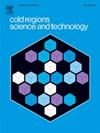Field observations on temperature characteristics and insulation performance of an extra-long highway tunnel in high-altitude cold regions
IF 3.8
2区 工程技术
Q1 ENGINEERING, CIVIL
引用次数: 0
Abstract
Temperature characteristics along tunnels in cold regions (CRTs) are the basis for insulation design and frost damage prevention. However, the temperature distribution patterns inside different CRTs generally differ significantly, particularly inside extra-long CRTs. This study conducts simultaneous field observations of air temperatures and wind data outside the tunnel portals, as well as air and lining temperatures along a 7527-m-long highway tunnel for over two years, thus exploring the driving effect of microclimates at the tunnel site on the interior temperature distributions. The results show that, due to the mountain climate effect, the air temperatures and wind data at the nearest municipal meteorological station, the tunnel entrance and exit differed considerably. Based on the interior air temperatures along the tunnel, the entire tunnel can be categorized into the entrance, middle and exit sections. At the entrance and exit sections, as the distance from the tunnel portals increased, the annual averages of the air temperatures rose at gradients of 0.06 and 0.07 °C per 100m, and the annual amplitudes decreased at gradients of 0.16 and 0.10 °C per 100m, respectively. However, the annual averages and annual amplitudes of the air temperatures in the middle section remained almost unchanged. Good insulation performance was observed within the insulated entrance (1000m long) and exit section (1200 m long), with the temperature differences between the two sides of the insulation layer ranging from 3.6 to 6.0 and from 4.2 to 3.2 °C, respectively. In the cold season, the frost profile along the tunnel was asymmetric. The freezing indices of the concrete lining within the entrance and middle sections were considerably larger than those within the exit section. Such as asymmetric frost profile along the tunnel is likely influenced by the chimney effect due to the air temperature difference between the entrance and exit, and the prevailing wind at the entrance during cold seasons. The field data and analyses will offer valuable case-study insights and could inform insulation design guidelines for the tunnel, pending further validation across varied geographies and tunnel configurations.
高寒地区超长公路隧道温度特性及保温性能的现场观测
寒冷地区隧道的温度特性是进行隧道保温设计和防冻损的基础。然而,不同crt内的温度分布模式通常差异很大,特别是在超长crt内。本研究对7527m长的公路隧道进行了为期两年多的隧道洞口外气温、风资料、空气和衬砌温度的同步野外观测,探讨了隧道现场小气候对隧道内部温度分布的驱动作用。结果表明:由于山区气候的影响,最近的市立气象站的气温和风资料,隧道的出入口存在较大差异;根据隧道沿线的室内气温,将整个隧道分为入口、中间和出口三个部分。在入口和出口段,随着距离隧道入口的增加,年平均气温分别以0.06和0.07°C / 100m的梯度上升,年平均气温以0.16和0.10°C / 100m的梯度下降。而中部气温的年平均值和年振幅基本保持不变。保温入口段(长1000m)和出口段(长1200 m)保温性能良好,保温层两侧温差分别为3.6 ~ 6.0℃和4.2 ~ 3.2℃。在寒冷季节,隧道沿线的霜冻剖面不对称。混凝土衬砌在入口和中间段的冻结指数明显大于出口段。如隧道沿程不对称的结霜分布,可能是由于入口和出口的温差造成的烟囱效应,以及寒冷季节入口盛行风的影响。现场数据和分析将提供有价值的案例研究见解,并可以为隧道的绝缘设计指南提供信息,等待在不同地理位置和隧道配置上的进一步验证。
本文章由计算机程序翻译,如有差异,请以英文原文为准。
求助全文
约1分钟内获得全文
求助全文
来源期刊

Cold Regions Science and Technology
工程技术-地球科学综合
CiteScore
7.40
自引率
12.20%
发文量
209
审稿时长
4.9 months
期刊介绍:
Cold Regions Science and Technology is an international journal dealing with the science and technical problems of cold environments in both the polar regions and more temperate locations. It includes fundamental aspects of cryospheric sciences which have applications for cold regions problems as well as engineering topics which relate to the cryosphere.
Emphasis is given to applied science with broad coverage of the physical and mechanical aspects of ice (including glaciers and sea ice), snow and snow avalanches, ice-water systems, ice-bonded soils and permafrost.
Relevant aspects of Earth science, materials science, offshore and river ice engineering are also of primary interest. These include icing of ships and structures as well as trafficability in cold environments. Technological advances for cold regions in research, development, and engineering practice are relevant to the journal. Theoretical papers must include a detailed discussion of the potential application of the theory to address cold regions problems. The journal serves a wide range of specialists, providing a medium for interdisciplinary communication and a convenient source of reference.
 求助内容:
求助内容: 应助结果提醒方式:
应助结果提醒方式:


